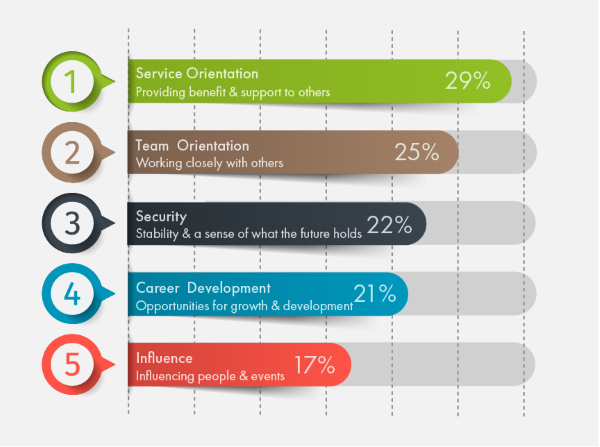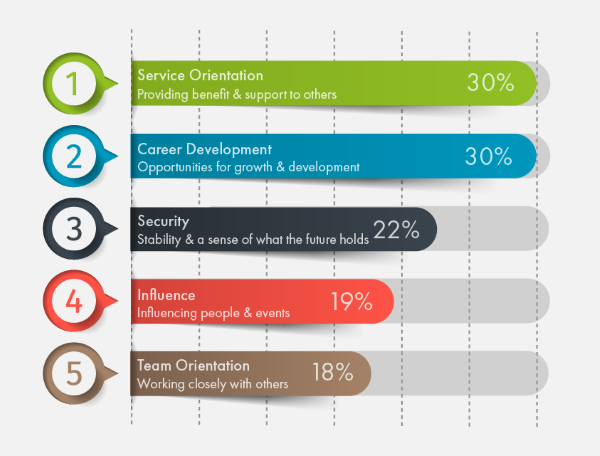
Engaging Employees During Disengaged Times

Author: Shawn Bakker
In February 2020 I had just returned from a trip to Cuba with friends. I then lead a four-day, in-person training program for 15 people. Then the world changed.
Since then I have been tracking the shifts in employees’ values, needs and desires. By examining the data from our Career Values scale , I found there has been a change in what employees report as important to them, and leaders are out-of-touch with this change.
Before the pandemic, the most important sources of satisfaction for employees were ranked as follows:

Note: Data shows the percentage of people who selected the specific career value as one of their most important.
During the pandemic there was a significant shift. Below are the results from the last year and a half:

The number of people valuing Career Development has increased significantly; 50% more people endorse it now than they did before. So considerably more people are looking for opportunities to learn new skills, tackle new challenges, and move forward in their career.
This increased importance of development has come with a significant drop in the number of people who value Team Orientation. Twenty-five percent fewer people list working closely with others as important. What previously was the second highest ranking value has fallen all the way to fifth. As people have worked through the pandemic, their sense of teamwork and level of connection has decreased. At the same time, they are also exploring new avenues of development in greater numbers. Employees are asking themselves “Is this all there is in this place?” Many are finding the answer to that question to be yes, and leaving.
To engage employees who are feeling disconnected and expressing a higher desire for career growth, leaders need to get active. They need to begin asking employees “What could make this better?” Then implement changes based on what they hear. Recent research from McKinsey & Company 1 shows that leaders do not have a great read on what is truly important to employees – so leaders need to shelve what they think might be the problem, and listen to what employees tell them instead.
For many leaders, this requires them to shift away from their natural, more analytical and task-focused approach. Leading people, especially those who are working remotely, requires greater effort on the part of leaders to initiate connections, involve others, and understand of the needs of employees. This shift to higher levels of consultation and collaboration allows leaders to target the real reason for poor engagement and attrition – the misalignment in needs, values and desires.
I would like to end with a few tips for both employees and leaders.
Tips for Employees – To more effectively explore new options
- Clarify and articulate your values. It is tough to find satisfaction if you don’t know what you are looking for.
- The organizational psychologist Adam Grant has said “Before you quit your job, it’s worth exploring ways to improve your job.”
- Planned happenstance. It is important to have a strategy for pursuing new opportunities, but you also need to be ready and open to pivoting when necessary. Make sure you balance planned and emergent strategies.
Tips for Leaders – To more effectively value employees
- Initiate and maintain connections. You can only make things better for employees by asking them.
- Develop employees. What are you doing in this space? Employees want to learn, grow and expand their capabilities. If they don't think they can do that in your organization, they will look elsewhere.
- Develop self. Learning and growth are as important for leaders as they are for employees.
- Learn and pivot. Take what you hear from employees and make changes.
Employees leave jobs for positions that fit them better, and job change is influenced by some simple calculus: Increased job satisfaction + Fewer work-family conflicts = Less job change 2 . If leaders can actively work with employees to find ways to increase job satisfaction by aligning with employee values they can make their organization a much more engaging place to be.
References:
2. Sons M, Niessen C. Cross-lagged effects of voluntary job changes and well-being: A continuous time approach. J Appl Psychol. 2021 Oct 14. doi: 10.1037/apl0000940. Epub ahead of print. PMID: 34647782
About the Author : Shawn Bakker is a registered Psychologist and leads the Professional Services team at Psychometrics Canada.
https://www.linkedin.com/in/shawn-bakker/
The views and opinions expressed in this blog post belong solely to the original author(s) and do not necessarily represent the views and opinions of CPHR Alberta.
The views and opinions expressed in this blog post belong solely to the original author(s) and do not necessarily represent the views and opinions of CPHR Alberta.





